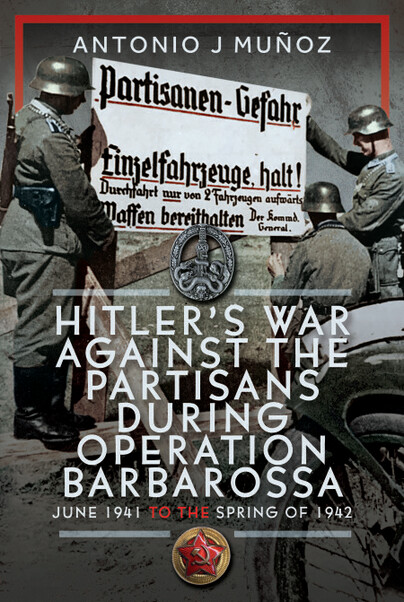Hitler’s War Against the Partisans During Operation Barbarossa (Hardback)
June 1941 to the Spring of 1942

Pages: 272
Illustrations: 1x16 b&w plates
ISBN: 9781036121495
Published: 21st March 2025
(click here for international delivery rates)
Need a currency converter? Check XE.com for live rates
| Other formats available | Price |
|---|---|
| Hitler’s War Against the Partisans… ePub (26.9 MB) Add to Basket | £18.99 |
From the start of the war on the Eastern Front, Hitler’s Ostheer, his Eastern Army, would wage a vernichtungskrieg, or war of annihilation, in the East. Never before had such a wide-reaching campaign been fought.
Preparations for Germany’s invasion of the Soviet Union had included the drawing up of plans and allocation of resources to secure the newly conquered territories. These plans included the premeditated murder of many innocent civilians. Adolf Hitler said as much when in July 1941, shortly after Stalin ordered the formation of partisans, he told his Army High Command: ‘This partisan war has some advantage for us; it enables us to eradicate everyone who opposes us.’
Anticipating resistance to Nazi occupation and rule, Hitler instructed the Ostheer to act ruthlessly, not only on the front lines but in the rear areas as well. When, in July 1941, Stalin ordered partisan forces to be created, the stage was therefore set for the largest and most savage conflict ever waged between a modern military force and a guerrilla army. The scale of the partisan and anti-partisan war on the Eastern Front was as costly and bitterly fought as the struggle on the front lines themselves. Employing thousands of primary source documents and scouring eight separate state archives in six countries over a twenty-two-year period, Antonio J. Muñoz has produced what can be described as a definitive account of this part of the war behind the front lines in the East during the invasion of the Soviet Union.
From the very beginning, the Nazis fought this war ruthlessly, by eliminating not only actual guerrillas, but a good portion of the civilian population. Employing dozens of wartime anti-partisan operational instructions, plus newly-created detailed battle maps and full orders of battle, Dr. Muñoz brings this little-known conflict behind the lines into focus for the very first time.
The war behind the lines is detailed by district. This includes the Reichskommissariat Ostland region, which comprised the Generalbezirk Estland (Estonia), Generalbezirk Lettland (Latvia), Generalbezirk Litauen (Lithuania), Generalbezirk Bialystok (Northeastern Poland), and Generalbezirk Weißruthenien (Belarus). The book also covers the guerrilla and anti-partisan war in the Reichskommissariat Ukraine (Ukraine region) as well as in north, central and southern Russia. For Russia proper, anti-partisan operations against the guerrillas are broken down by army group area.
Not only are the operations described, but the reader will also learn about guerrilla attacks and how the entire partisan movement grew from year to year, and region to region. Hitler’s War Against the Partisans During Operation Barbarossa documents the whole of the beginning of the savage partisan war between June 1941 and the spring of 1942. Never before has every major, and some minor, anti-guerrilla operation been described in such detail.
There are no reviews for this book. Register or Login now and you can be the first to post a review!
About Antonio J Muñoz
ANTONIO J. MUÑOZ is a retired professor of history living in New York city. He joined the United States Marine Corps right after graduating from high school. He served honorably for four years, two of them with the Fleet Marine Force Atlantic. He obtained his bachelor’s and master’s degree in history from Queens College. He later attended St. John’s University, where he received a doctorate in history. Before he retired, he taught at St. John’s University and, later, at Farmingdale State College. Dr. Muñoz has previously been published. His study The German Secret Field Police in Greece, 1941-1944 was released in 2018. He has been married for forty-three years and has several grandchildren. His family in Spain hails from the province of Asturias while his wife’s family is from Galicia. He and his family hold dual American and Spanish citizenship.


















